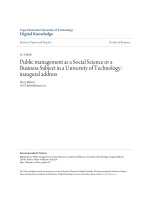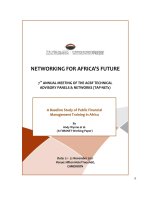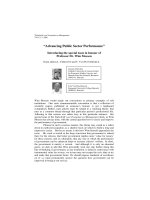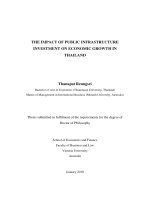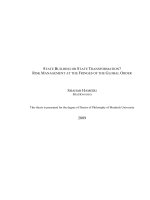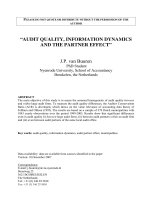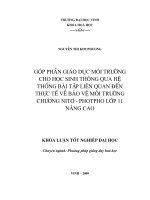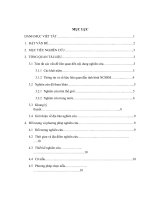Thanapat reungsri luận án tiến sỹ của tác giã nước ngoài liên quan đến đề tài về kiểm toán
Bạn đang xem bản rút gọn của tài liệu. Xem và tải ngay bản đầy đủ của tài liệu tại đây (2.31 MB, 295 trang )
THE IMPACT OF PUBLIC INFRASTRUCTURE
INVESTMENT ON ECONOMIC GROWTH IN
THAILAND
Thanapat Reungsri
Bachelor of Arts in Economics (Thammasat University, Thailand)
Master of Management in International Business (Monash University, Australia)
Thesis submitted in fulfilment of the requirements for the degree of
Doctor of Philosophy
School of Economics and Finance
Faculty of Business and Law
Victoria University
Australia
January 2010
i
Abstract
Infrastructure traditionally holds centre place in nations‟ economic planning. New
infrastructure promotes economic growth, expands trade, reduces poverty and improves the
environment. Its importance worldwide invites significant informed debate over the effects of
public infrastructure investment on economic development.
In economic downturns, the weighting of infrastructure investment in national budgets
makes it a frequent contender for substantial cuts. During the Asian economic crisis in 1997,
many infrastructure projects in Thailand were suspended or terminated. The inability to
maintain an appropriate level of expenditure led to substandard transport and utilities for the
country, impeding its growth. Because of the crisis, a fiscal sustainability framework was
established by the Thai government to ensure adequate levels of revenue and investment
expenditure within a balanced budget.
This study investigates the effects of public infrastructure investment on economic
growth under Thailand‟s fiscal sustainability framework. A recursive supply-side model
based on the Standard Neoclassical Model framework is used using Thai national data on
public revenue (taxes, non-tax revenue and debt) to estimate infrastructure investment. An
aggregate production function is used based on quarterly time series data from 1993 to 2006.
This period comprises economic circumstances in Thailand including recession and recovery.
Variables were subjected to unit root test to justify stationary status. If all variables were
stationary, the Ordinary Least Square (OLS) method was used in estimation. If all variables
were non-stationary and of an order I(1), then the cointegration test was conducted for long-
run equilibrium. If the variables confirm cointegration, then the Error Correction Model was
estimated using OLS, as the error correction term is constructed to estimate for coefficients. If
the variables were found to have a mix of stationary and non-stationary variables, then the
Autoregressive Distributed Lag model was used in the estimation. Finally, a simulation
process was conducted, based on the estimated model, termed Infrastructure Finance Model
for Emerging Economies. Simulation was carried out with ex-ante and ex-post scenarios: to
generate a time-path within the data time period to prove model consistency; and for time-
path values beyond the time period to provide prediction for policy decisions. The simulation
consists of five scenarios: maximum borrowing or 20 per cent of budget; 15 per cent of
budget; 10 per cent of budget; 5 per cent of budget; and no borrowing, or no effect on budget.
ii
The results indicate that public infrastructure investment has a mixed effect on
domestic growth. A positive result is found in lagged public investment as a proportion of
GDP at the third quarter, confirming that infrastructure capital has a positive significant effect
on economic growth. However, a negative impact is found in lagged real government
investment at the second quarter. As public investment increases, the demand for resources
also increases and, given full capacity for the economy, this may lead to increased costs of
private investment, resulting in a fall in private investment and thus reduce economic growth
(crowding-out effect). Hence, under conditions of full capacity, an increase in public
investment could result in negative impact on growth. The Infrastructure Finance model is
therefore a useful indicator of private sector intentions for resource expenditure.
iii
Declaration
“I, Thanapat Reungsri, declare that the PhD thesis entitled The Impact of Public
Infrastructure Investment on Economic Growth in Thailand is no more than 100,000 words
in length including quotes and exclusive of tables, figures, appendices, bibliography,
references and footnotes. This thesis contains no material that has been submitted previously,
in whole or in part, for the award of any other academic degree or diploma. Except where
otherwise indicated, this thesis is my own work”.
Signature Date
iv
Acknowledgements
My sincere gratitude is extended to those who contributed to the fulfilment of this
study. Deep appreciation is offered to Dr Kandiah Jegasothy, my principal supervisor from
the School of Applied Economics, Victoria University, for his generous guidance and
encouragement throughout. As well as academic assistance, Dr Jegasothy assisted me in
gaining a new perspective on life overcoming difficulties that arose during the years of
studying. My appreciation is also extended to Dr Segu Zuhair, my co-supervisor from the
School of Applied Economics, Victoria University, for his constructive comments and
suggestions in writing this thesis.
The financial support extended by the Thai Bureau of the Budget was the foundation
for this undertaking and I thank them sincerely for the opportunity to contribute this thesis for
the benefit of my country.
I owe a great debt to my father, parents-in-law, sister, brother, colleagues and friends
for their understanding and encouragement during a difficult time.
The honour of this success is dedicated to my mother, who passed away in a car
accident in October 2007. She gave me the confidence to pursue my dream so that I could set
out to make this doctoral degree a reality.
Of great importance is the person who made this honour possible; my wife Patama
Suchikul Reungsri has always stood by my side, supporting and encouraging me. I also thank
my daughter, Napaskul Suchikul Reungsri (Melbourne) for being my inspiration and making
me laugh during hardship.
v
Dedication
Dedicated to the three ladies of my life
Mother, Sutusanee Reungsri
Wife, Patama Suchikul Reungsri
Daughter, Napaskul Suchikul Reungsri
vi
Table of Contents
Abstract i
Declaration iii
Acknowledgements iv
Dedication v
List of Abbreviations ix
List of Tables xi
Chapter 1 Introduction to Study 1
1.1 Research Antecedents 1
1.2 Statement of Purpose 5
1.3 Study Objectives 6
1.4 Research Scope and Significance 7
1.5 Methodology 9
1.6 Chapter Summary 10
Chapter 2 Context of the Research 12
2.1 Economic Growth 12
2.1.1 Economic Growth Theory 13
2.1.2 Determinants of Economic Growth 16
2.2 Infrastructure Development 18
2.2.1 Definitions 19
2.2.2 Measures 20
2.2.3 Economic Effects 21
2.2.4 Social Effects 22
2.2.5 Studies on Development 26
2.2.6 Summary 29
2.3 Infrastructure Finance 29
2.3.1 Sources 29
2.3.2 Studies on Financing 32
2.4 Conclusion 35
Chapter 3 Methodology Review 37
3.1 Model Overview 38
3.2 Single Equation Models 39
3.2.1 Production Function 39
3.2.2 Cost function 45
3.2.3 Profit function 47
3.2.4 Dual function 48
3.2.5 Function Analysis 50
3.3 System Models 51
3.3.1 Full Market Models 52
3.3.2 Partial Market Models 58
3.4 Model Review 59
3.5 Conclusion 60
Chapter 4 Study Context: Thailand 61
4.1 National Economic and Social Development Plans 61
4.1.1 First Plan 1961–1966 62
4.1.2 Second Plan 1967–1971 65
4.1.3 Third Plan 1972–1976 66
vii
4.1.4 Fourth Plan 1977–1981 67
4.1.5 Fifth Plan 1982–1986 68
4.1.6 Sixth Plan 1987–1991 69
4.1.7 Seventh Plan 1992–1996 70
4.1.8 Eighth Plan 1997–2001 73
4.1.9 Ninth Plan 2002–2006 74
4.1.10 Summary of Plans and Infrastructure Investment 75
4.2 Thailand‟s Infrastructure 77
4.2.1 Expenditure 77
4.2.2 International Competitiveness 78
4.3 Sources of Infrastructure Finance 80
4.3.1 Public Revenue 82
4.3.2 Deficit Financing 100
4.4 Summary 106
Chapter 5: Methodology and Analytic Model 108
5.1 Methodology 108
5.2 Conceptual Framework 109
5.3 Model Structure 110
5.4 Model Components 111
5.4.1 Budget Overview 112
5.4.2 Defined Revenue Streams 116
5.4.3 Direct Tax Equations 118
5.4.4 Indirect Tax Equations 123
5.5 Raw Data and Sources of Data 129
5.6 Data Transformation 131
5.7 Estimation Issues 132
5.7.1 Stationary and Non-stationary 132
5.7.2 Testing for Unit Roots 134
5.7.3 Error Correction Model 137
5.7.4 Cointegration 137
5.7.5 Autoregressive Distributed Lag 138
5.8 Estimation Procedure 140
5.9 Simulation Procedure 140
5.10 Conclusion 141
Chapter 6: Model Estimation and Simulation 142
6.1 Public Revenue Estimation 143
6.1.1 Estimation PIT 143
6.1.2 Estimation CIT 150
6.1.3 Estimation Petroleum Tax 158
6.1.4 Estimation Indirect Taxes 160
6.1.5 Estimation Foreign Borrowing 167
6.1.6 Estimation Debt Management 167
6.2 Public Infrastructure: Factor of Production 168
6.3 Model Estimation Results 171
6.4 Aggregate Production Function 173
6.5 Infrastructure Finance Model for Emerging Economies 175
6.5.1 Ex ante Scenario Simulation 176
6.5.2 Ex post Simulation 178
6.6 Discussion 179
6.6.1 Economic Functionality 180
viii
6.6.2 Model Application 182
6.7 Conclusion. 184
Chapter 7 Policy Discussions, Recommendations and Conclusions 185
7.1 Study Overview 186
7.2 Study Results 187
7.3 IFMEE Explained 188
7.4 Policy Implications 190
7.5 Research Limitations 192
7.6 Recommendations for Further Research 193
7.7 Final 194
References 196
ix
List of Abbreviations
ADF
Augmented Dickey-Fuller
AEC
Asian Economic Crisis
ARDL
Autoregressive Distributed Lag
BIBF
Bangkok International Bank Facility
BOB
Bureau of the Budget
BOT
Bank of Thailand
C-D
Cobb-Douglas
CGE
Computable General Equilibrium
CIT
Corporate Income Tax
CPI
Consumer Price Index
CRTS
Constant Returns to Scale
DB
Domestic Borrowing
DF
Dickey-Fuller
DW
Durbin-Watson
ECM
Error Correction Model
ETR
Effective Tax Rate
FB
Foreign Borrowing
FPO
Fiscal Policy Office
FTA
Free Trade Agreement
FY
Fiscal Year
1
GDP
Gross Domestic Product
GNP
Gross National Product
HD
Harrod-Domar
ICOR
Incremental Capital Output Ratio
IFMEE
Infrastructure Finance Model for Emerging Economies
IMD
Institute for Management Development
IMF
International Monetary Fund
IMGPI
Import Goods Price Index
IPPI
Private Investment Price Index
JJ
Johansen and Juselius
LM
Lagrange Multiplier
L-R
Long-Run
MOF
Ministry of Finance
NBER
National Bureau of Economic Research
NEDB
National Economic Development Board
NESDB
National Economic and Social Development Board
1
Fiscal Year in Thailand starts from October to September
x
Abbreviations (cont.)
NIEs
Newly Industrialising Economies
OECD
Organisation for Economic Co-operation and Development
OLS
Ordinary Least Squares
PDMO
Public Debt Management Office
PIT
Personal Income Tax
PPP
Public-Private Partnership
PT
Petroleum Income Tax
R&D
Research and Development
RI
Retained Income
RTG
Royal Thai Government
SALs
Structural Adjustment Loans
SBT
Specific Business Tax
SEC
Stock Exchange Commission
SNM
Standard Neoclassical Model
SOEs
State Own Enterprises
S-R
Short-Run
TFP
Total Factor Productivity
THB
Thai Baht
TL
Transcendental Logarithmic
UNESCO
United Nations Educational Scientific and Cultural Organization
VAR
Vector Autoregression
VAT
Value Added Tax
xi
List of Tables
Page
1.1 Fiscal sustainability framework 4
1.2 Retained Income from Non-financial SOEs and GDP, 1993-2006 5
4.1 First Plan GDP 1961-1966 61
4.2 Second Plan GDP 1967-1971 65
4.3 Third Plan GDP 1972-1976 66
4.4 Fourth Plan GDP 1977-1981 67
4.5 Fifth Plan GDP 1982-1986 68
4.6 Sixth Plan GDP 1987-1991 70
4.7 Seventh Plan GDP 1992-1996 71
4.8 Critical Infrastructure Response Plan 1990-2001 72
4.9 Eighth Plan GDP 1997-2001 73
4.10 Ninth Plan GDP2002-2006 75
4.11 Summary of GDP During the Nine Plans 1962-2006 75
4.12 Summary of Nine Plans Infrastructure Program 1962-2006 76
4.13 Selected Countries Ranked for Competitiveness, 2000-2004 79
4.14 World Infrastructure Stocks, per Capita Income, 2000 79
4.15 Public Revenue Sources 1993-2006 83
4.16 Direct and Indirect Tax Trends, 1993-2006 85
4.17 Direct Tax Revenue Components, 1993-2006 86
4.18 Personal Income Tax Rates, 2006 87
4.19 Personal Income Tax Components, 1993-2006 87
4.20 Withholding Tax Rates, 2006 88
4.21 Personal Income Tax: Deductions and Allowances 2006 90
4.22 Corporate Income Tax, 2006 91
4.23 Corporate Income Tax 1993-2006 92
4.24 Withholding CIT Tax Rates, 2006 93
4.25 Indirect Tax 1993 – 2006 94
4.26 Specific Business Tax 2006 97
4.27 Excise Tax Components, 1993-2006 98
4.28 Non-tax Revenue & Retained Income Components, 1993-2006 99
xii
4.29 Fiscal Balance 1993-2006 102
4.30 Capital Expenditure Proportionate to Budget Expenditure 1993-2006 103
4.31 Holders of Government Domestic Debt 1993-2006 105
4.32 Net External Debt to Total Public Debt 1993-2006 106
5.1 Budget Expenditure Categories 1998-2006 112
5.2 Categories of Domestic Public Debt 2002-2006 114
5.3 State Owned Enterprises: Retained Income & Capital Expenditure 1993-2006 115
5.4 Rebate Trends for VAT and PIT/CIT 1993 to 2006 117
5.5 Sources of Data 130
5.6 Data Transformation 131
6.1 Withholding PIT/GDP Variables: Unit Root Test Results 144
6.2 PIT on Interest: Unit Root Test Results 146
6.3 Other PIT: Unit Root Test Results 148
6.4 Annual CIT: Unit Root Test Results 151
6.5 CIT Service Sector and Repatriated Foreign Profits: Unit Root Test Results 153
6.6 Withholding CIT: Unit Root Test Results 155
6.7 Other CIT: Unit Root Test Results 157
6.8 Petroleum Tax: Unit Root Test Results 159
6.9 Domestic VAT: Unit Root Test Results 161
6.10 Import VAT: Unit Root Test Results 163
6.11 SBT: Unit Root Test Results 165
6.12 SBT: Long Run Variable Relationships 166
6.13 Public Infrastructure: Unit Root Test Results 169
xiii
List of Figures
Page
2.1 Transition Mechanism of Public Investment 21
3.1 Structure of Reviewed Approaches 38
4.1 North and Central Thailand: Water Infrastructure, 2006 64
4.2 Public Expenditure to GDP, 1976-2006 77
4.3 Sources of Infrastructure Investment 2006-2011 81
4.4 Withholding Tax: Monthly Patterns FY2005–2006 88
4.5 Personal Income Tax (Interest): Monthly Patterns FY2005–2006 89
4.6 CIT on Repatriated Profits Out: Monthly Patterns FY2005–2006 93
4.7 Customs Department Revenue, 1993 – 2006 96
4.8 Non-tax Revenue and Retained Income as Percentages of GDP, 1993-2006 100
4.9 Debt Servicing as a Percentage of Annual Budget 1996-2006 101
4.10 Domestic and External Debt 1997-2006 104
5.1 Public Revenue Sources for Infrastructure Investment 110
5.2 Budget Expenditure Categories 1998-2006 113
6.1 Real GDP Growth, Estimated and Actual:1994 - Q3 to 2006-Q2 174
6.2 Real GDP Estimated and Actual: 1994-Q2 to 2006-Q2 175
6.3 Ex ante Scenario Simulation: Real GDP 176
6.4 Infrastructure Finance Model for Emerging Economies 178
Appendixes
Appendix A: Plot of Variables A1
Appendix B: Table F A24
Appendix C: Unit Root Tests A25
Appendix D: Cointegration Tests A56
Appendix E: OLS Results A69
Appendix F: Diagnostic Tests A72
Appendix G: Long Run Cointegration Test A73
1
Chapter 1 Introduction to Study
Infrastructure is a profound determinant of nationhood, a measure of a country‟s
success on the world stage. Physical infrastructure may be viewed as the manifestation of a
country‟s economic power; social infrastructure‟s measures are the social capital and the
standard of living of its citizens. A country‟s infrastructure capital may accumulate over
generations or centuries, or it may occur over mere decades, as in East Asia and the Arabian
Gulf countries. A nation‟s physical infrastructure is generally taken to mean its public capital:
its community buildings such as hospitals and schools; transport nodes of airports, seaports,
rail and road networks; utility services such as water, power and waste services. Infrastructure
in all its commercial manifestations is viewed by governments as the means to attract
substantial private sector investment. This empirical research considers the manner by which
a country‟s infrastructure program is funded, and the interrelationships between infrastructure
development and economic growth experienced by developing countries, in particular,
Thailand.
This introductory chapter provides the research elements. First, the preparation for the
thesis is presented. Extant research on public infrastructure and its relationship to economic
growth is noted, together with an overview of the Thai financial environment. Next is the
statement of purpose followed by research objectives, explaining the framework of this
empirical research. The scope of the research and its significance within the literature are next
presented, followed by the methodology employed, based on quantitative analysis.
1.1 Research Antecedents
There is a high cost, both financial and national, to infrastructure capital development.
Governments may choose their projects unwisely, or conditions may change which render
their efforts obsolete, or, indeed, the infrastructure may not appear attractive to private
industry. The challenge for governments, including the Royal Thai Government (RTG), is to
balance infrastructure development planning and its expenditure to meet, but not exceed, the
objectives of social capital, or socio-economic growth, and those of the private sector.
Public infrastructure strategies are of great interest to economic researchers. Using a
range of methodologies, they explore the relationship between infrastructure and economic
growth. Primary in the literature is a sequential work by Aschauer (1989 references) where,
2
using production function method, the researcher finds high output elasticities for public
infrastructure capital. This triggered a well-documented debate, generally empirically based,
to define the relationship between public infrastructure and economic growth performance.
Confirming Aschauer‟s results, a majority of studies
2
find a strong and positive relationship
between the two variables; nevertheless, a significant number of researchers found little
evidence to support the positive effects of public infrastructure on growth
3
.
There is, however, relatively little discussion in the literature on the means by which
governments finance their public infrastructure programs. The funds flow required for a
particular public infrastructure program extending over several years can affect the economy
as a whole. An example of a large undertaking is that of building new capital cities, Brasilia
in 1960, and Naypyidaw in Myanmar/Burma in 2005. Brasilia‟s growth exceeded the
planners‟ expectations, thus affecting Brazil‟s capacity to fund infrastructure elsewhere;
whilst Rangoon‟s infrastructure and thus economic activity was adversely impacted by scarce
resources directed north to the new city. Alternatively, the cities that Saudi Arabia is building
for future generations in its regional areas offer the positive aspects of increased public and
social capital, and are within the Kingdom‟s capacity to develop.
Infrastructure development funding varies according to a country‟s circumstances. To
generate sustainable funding streams for projects, developing nations must trade successfully
on the world market and attract private finance. With its established infrastructure and free-
enterprise economy, and generally pro-investment policies, Thailand‟s robust economy is
successful in attracting international investment with its attendant financial flows into public
coffers. Indeed, the RTG relies on taxation for approximately 90 per cent of its revenue, the
majority of which is indirect tax (65%). Hence, if the government wishes to increase
infrastructure investments without reducing other government expenditures, it will need to
increase revenue through taxation or borrowing. For infrastructure investment, further sources
of finance are retained income and domestic and external debt (domestic and foreign
borrowings). However, the revenue generated from all these sources is insufficient for the
scale of infrastructure development that the government desires (MOF 2005).
2
Dalamagas 1995a; Lau & Sin 1997; Munnell 1990, 1992a, 1993; Otto & Voss 1994; Ram & Ramsey 1989;
Ramirez & Nazmi 2003; Wylie 1996)
3
Ford & Poret 1991; Holtz-Eakin 1994; Holtz-Eakin & Schwartz 1995a & 1995b; Hulten & Schwab 1991b; Sturm & De
Haan 1995).
3
As countries are subject to international scrutiny, the International Institute for
Management Development (IMD) is one organisation that reports on the competitiveness of
nations. Its World Competitiveness Scoreboard for 55 nations compares four competitiveness
factors: economic performance, government efficiency, business efficiency and infrastructure.
In 2008, Thailand was middle ranked at no. 27, index of 63, nevertheless up from no.33 the
year before. Its ranking, and therefore its competitiveness, was less than Japan‟s index 70;
Malaysia, index 73; China, index 73.8; Taiwan, index 77; Australia, index 83.5; Hong Kong,
index 95; and Singapore‟s index of 99. USA‟s index was 100. The results show that Thailand
should focus on public and private sector efficiency and performance, and especially plan for
infrastructure development (IMD 2008).
A country‟s infrastructure expenditure may reach a percentage of Gross Domestic
Product; it is thus discretionary, and vulnerable in times of budgetary restraint. This point is
illustrated by the 1997-1998 Asian Economic Crisis (AEC) when the majority of Thailand‟s
infrastructure projects, both planned and in construction, were affected by budgetary restraint
and subjected to a massive withdrawal of funding. This resulted in adverse social issues
regarding inadequate public facilities, made worse by infrastructure deterioration and
increasing population pressures. As part of its strategy to recover from the debilitating
economic effects of the crisis, RTG used infrastructure investment as a means to revitalise the
Thai economy; however, as noted, the government could not fund sufficient projects to meet
its infrastructure program.
In the years following the AEC, Bangkok pursued preferential trade agreements with a
variety of partners in an effort to boost exports and achieve high economic growth. Thailand
became one of East Asia's best performers in 2002-2004. Then the economy, and
infrastructure, was sequentially affected by the devastating 2004 Boxing Day tsunami, and the
military coup of 2006, with recovery slowed until the late 2007 elections. Foreign investor
interest was dampened in 2006 by a 30 per cent reserve requirement on capital inflows, and
discussion of amending Thailand's rules governing foreign-owned businesses. Nevertheless,
the Thai economy recovered, experiencing high export growth and GDP reached 4.5 per cent
in 2007.
The RTG thus learned from its AEC experience. The Ministry of Finance (MOF)
committed to a fiscal sustainability framework, including adequate funding for infrastructure
investment. The framework is illustrated below at Table 1.1, Fiscal Sustainability Framework.
4
Table 1.1
Fiscal Sustainability Framework
Fiscal Indicator
Target
(Percent)
Public debt/GDP
50
Debt service/budget
15
Budget balance
Balance
Capital expenditure/budget
25
Source: MOF (2005)
Table 1.1 outlines the four components of the targeted fiscal sustainability framework
adopted in Thailand. The first component of the MOF framework targets the public debt to
GDP ratio to 50 per cent. Second, servicing debt must remain under or equal to 15 per cent of
the RTG‟s budget, which, third, should be balanced. The last item of the framework is that
capital expenditure must be at least 25 per cent of the annual budget. The Framework thus
restricts the MOF‟s flexibility in deficit financing (MOF 2005). A further financial response
adopted by the RTG was the Public Debt Management Act 2005, which, inter alia, controls
government debt. When budgetary expenditures exceed revenue, the MOF may borrow up to
20 per cent of budgetary expenditures plus allowance for extraordinary expenditures, and 80
percent of approved budgeting on debt principle repayment (RTG 2005).
Besides taxation, as noted above, public funds are sourced from retained income, that
is, the revenue from state-owned enterprises (SOEs), minus expenditure, corporate income
tax, dividends and distribution, and bonuses paid to employees. A history of retained earnings
is shown at Table 1.2 Retained Income from Non-financial SOEs and GDP, 1993-2006,
below.
5
Table 1.2
Retained Income from Non-financial SOEs and GDP, 1993-2006
Year
Retained
Income
(Billion Baht)
GDP
(Billion Baht)
Per cent
of GDP
1993
87.92
3,165.20
2.78
1994
108.79
3,629.30
3.00
1995
132.19
4,186.21
3.16
1996
148.33
4,611.04
3.22
1997
113.72
4,732.61
2.40
1998
116.14
4,626.45
2.51
1999
118.26
4,637.08
2.55
2000
123.13
4,922.73
2.50
2001
155.32
5,133.50
3.03
2002
183.48
5,446.04
3.37
2003
197.53
5,930.36
3.33
2004
201.71
6,576.83
3.07
2005
263.34
7,195.00
3.66
2006
233.85
7,820.93
2.99
Average
2.97
Source: BOT (2007)
At Table 1.2, retained income from public enterprises external to the financial sector
shows a retraction and then slow growth after the 1996-1997 AEC, accelerating as the
economy recovers. Similarly, retained income as a percentage of GDP rises until 2002 and
then remains relatively stable, averaging 2.94 per cent over the decade.
Public financing for its infrastructure program is critical to Thailand‟s economy. This
study explores issues which underlie the fiscal sustainability framework, and their existing
and potential impacts on the country‟s economy. This empirical research is conducted through
quantitative analysis techniques derived from statistical literature, and its findings therefore
allow comparison with other economic research, and thus add to the body of knowledge.
1.2 Statement of Purpose
The majority of research, as noted above, supports a significant and positive
relationship between public infrastructure and economic growth. Nevertheless, there is an
element of risk involved for government policymakers who depend on such research to
6
predicate economic outcomes from various strategies. This risk is especially relevant in Thai
public funding, where there is no empirical study on the relationship between the two
variables. The majority of related studies refer to the positive and significant relationship
found by Aschauer (1989a); however, the impact of public infrastructure on economic growth
in Thailand remains unclear.
Moreover, financing public infrastructure is a crucial issue, especially in emerging
economies where budgetary surpluses are difficult to achieve and income flows are vulnerable
to global forces (Merna & Njiru 2002). Because incomes are lower in developing countries,
savings are low and thus investment is low. Older and stronger economies have the financial
resources to recover quickly from an economic downturn. Generating sufficient public
infrastructure funds arguably will remain an issue for Thailand, and academic inquiry is
necessary to give some direction to its policymakers. This is the statement of purpose for this
thesis.
In relation to the statement of purpose, this empirical research poses two questions, the
first of which is To what extent can the Thai government raise funds for infrastructure
investment under its fiscal constraints? This question should first be resolved, which allows
the second question to be raised: What is the impact of fiscal constraints on economic growth
in Thailand? To address the first question, a public revenue generation model is presented
which estimates the public revenue available for public infrastructure investment under
different conditions. The second question is answered using 1993 to 2006 government
investment data, analysed by Aschauer‟s production function approach.
As public investment outflows are continuous, the study, to answer the primary
question on funds raising, simulates time-paths for investment capacity and economic growth.
In such simulation processes, various scenarios are generated by placing parameters for
government debt, including domestic and foreign borrowing variables. This methodology
confirms the consistency of the model performance.
1.3 Study Objectives
The aim of this research is to identify the inputs and the processes comprising public
infrastructure investment in Thailand. This study includes a literature survey, identification of
relevant public finance data, then a quantitative analysis leading to conclusions and findings
for the following objectives:
7
define the effects of public infrastructure on economic growth in Thailand
develop a public revenue generation model to determine the country‟s capacity to
invest under fiscal policy constraints; acting through alternative public financing
methods
simulate the effects of public infrastructure on economic growth due to variations
in fiscal policy constraints; again acting through alternative financing methods.
1.4 Research Scope and Significance
This study examines the effects of public infrastructure investment on economic
growth in Thailand, by means of empirical research and quantitative analysis. It should be
noted that, as the social consequences of infrastructure investment are difficult to measure and
little data are available, the financial aspects of public infrastructure investment alone are
analysed.
The scope and design of the research is as follows. First, a literature review is
undertaken to identify the nature of extant research on infrastructure inputs and effects, and to
analyse the themes that emerge from the findings. Further, international research is examined
over the relevant period to find points of comparison with Thailand‟s experiences. Second,
the study is timely, as public infrastructure investment has recently achieved a policy focus in
Thailand. As Thailand is a developing country, this study extends research from its existing
focus on the financial environments of mature economies to the dynamics of an emerging
economy. Thirdly, this study concentrates on the quarterly time series data from 1993:Q1 to
2006:Q4. The period covers different economic circumstances in Thailand of recession and
recovery. Moreover, the complete data on public revenue are only available from 1993
onward.
The significance of this research is embedded in the notion that adequate investment
in national infrastructure is critical to socio-economic growth for Thailand, thus finance is an
ongoing priority for the RTG. The circumstances regarding infrastructure finance, and the
relationships between public infrastructure and economic growth, are the topics of
considerable debate in developed economies; however, there are few Thai studies of this
nature. Findings of researchers studying other economies under other conditions may indeed
have relevance to the case in Thailand; nevertheless, these assumptions should be tested.
8
Moreover, researchers generally consider only public finance through either taxation
and debt financing, or taxation and seigniorage financing
4
. In practice, governments may
access various sources and combinations of finance. Sources for fiscal policy financing
comprise taxation revenue, domestic and foreign borrowings, and retained income. If not
already fully exploited, these facilities can contribute considerable additional public capital to
permit funds flows to infrastructure development. The volume of potential finance available
to RTG is therefore a significant element of this study.
In addition, empirical studies in Thailand focus on the market equation model,
omitting the public infrastructure investment issue and financing sources. Thus, in this study,
system estimation investigation permits the omitted elements to be addressed.
This study contributes to the literature through a series of innovative approaches and
regional applications. It is timely and relevant to the RTG policymakers, as the following
factors illustrate.
There is no identified research that investigates public infrastructure expenditure‟s
impact on Thai economic growth, presumably due to a lack of data. Public
infrastructure-related studies for Thailand tend to rely on Aschauer (1989a) who
found a significant and positive effect of public infrastructure on economic
growth.
The Thai literature does not distinguishing between public consumption and public
investment. This research places emphasis on public investment, specifically,
infrastructure investment. The intended effect of this emphasis is to provide
specific knowledge and a deeper understanding of the impact of public investment,
especially infrastructure, on the Thai economy. This facilitates more effective
policymaking for investment-specific policies.
The literature strongly supports the notion that public infrastructure investments
significantly and positively affect economic growth. However, few studies address
the financing of infrastructure and those that mention this aspect do so
superficially. This study takes the approach that finance is a function of
investment; investment is an indicator of economic growth; and these arguments
may be „located‟ within the RTG‟s fiscal sustainability framework.
4
Espinosa-Vega & Yip 1999, 2002; Hung 2005; Levine & Krichel 1995; Ozdemir 2003; Palivos & Yip 1995
9
The literature tends to consider only two sources of public financing: taxation and
deficit financing. This study attempts to extend the research by including other
sources of debt financing, and retained income.
There are few Thai studies, as noted, and those researchers tend to use the market
model equation for analysis without specifically addressing public infrastructure
investment. This study includes infrastructure investment with quantitative
analysis through a recursive supply-side system equation model.
1.5 Methodology
The methodology for this empirical research employs quantitative analysis. The
computation for the estimation of public revenue and aggregate production function is based
on quarterly time series data taken from the first quarter (Q1), 1993 to the fourth quarter (Q4),
2006. This timeframe encompasses a period of recession (the AEC) and Thailand‟s
subsequent recovery despite natural disaster and political uncertainty.
The data were obtained from the Bank of Thailand, the National Economic and Social
Development Board, the Ministry of Finance, the Revenue Department, the Excise
Department, and the Customs Department. A recursive supply-side model based on the
Standard Neoclassical Model framework is used. All variables used in the study are aggregate
national data, and as such are subject to the unit root test using Dickey-Fuller and the
Augmented Dickey-Fuller test to justify the stationary status. Implications of the unit root test
result on the estimation procedures are first, no unit root, i.e., all variables are stationary, thus
the Ordinary Least Square (OLS) method can be used in estimation. Second, if all variables in
the equation are found to be non-stationary and of an order I(1), then the cointegration test
can be conducted to find the existence of a long-run equilibrium relationship. If the variables
confirm the existence of cointegration, then the conventional Error Correction Model is
estimated using OLS which confines short-run dynamics and long-run equilibrium as the error
correction term will be constructed using the Error Correction Model to estimate for
coefficients. Third, if the variables are found to have a mixture of stationary and non-
stationary variables, then the Autoregressive Distributed Lag model is used in the estimation.
Finally, a simulation process is conducted, based on the estimated model. The variable
that has been paramatised in the model is the government borrowing including domestic
borrowing and foreign borrowing. Simulation is carried out with ex-ante and ex-post
10
scenarios. An ex-ante scenario involves generation of a time-path within the data time period
to validate model consistency. The ex-post scenario involves generation of time-path values
beyond the time period used during the analysis, and thus provides prediction for
decisionmaking. The simulation consists of five scenarios: maximum borrowing or 20 per
cent of budget; 15 per cent of budget; 10 per cent of budget; 5 per cent of budget; and no
borrowing, or no effect on budget.
1.6 Chapter Summary
This thesis consists of seven chapters, the order of which follows. Chapter 1
introduces the study on the relationship between public infrastructure and economic growth,
and comments on the factors that initiated the research, its purpose and methodology. Chapter
2, a comprehensive literature survey, explores the nature of extant research on public
infrastructure, governments‟ varied means for funding and their preferred strategies, and
differences between fiscal responses based on regional economic environments. Of particular
interest to this study are reported findings and conclusions on the effects of public
infrastructure programs on economic growth.
Considerable research, involving several theoretical approaches and models, focuses
on the relationship between public infrastructure and economic growth, Chapter 3 reviews the
model structures employed for the various analyses of this relationship; further, the chapter
includes extant studies on financing infrastructure programs, the findings of which are used
for later comparison in this study.
Chapter 4 returns to the empirical nature of this research and provides an overview of
Thailand‟s environment, its economic and infrastructure development, together with an
analysis of infrastructure investment demand. To meet the objectives of this thesis, that is,
identifying potential funding (s1.3), the public finance structure in Thailand is reviewed.
The study‟s methodology and its analytical model design structure are discussed in
Chapter 5, together with information on the data sources and the nature of their data. At this
point, the selected econometric model estimation techniques are also discussed in preparation
for the data analysis. Chapter 6 provides the estimation analysis and all results. The model
simulation is conducted using ex-ante and ex-post techniques and the results are compared
with extant research findings.
11
Chapter 7 summarises the major findings of the study, drawing conclusions from the
findings, and notes policy implications for Thailand‟s decision makers. These include
potential sources of finance which could be diverted to infrastructure, the relationship
between infrastructure investment and economic development, and potential synergies that
could assist Thailand‟s growth prospects. Finally, the limitations of the thesis are
acknowledged, and there are suggestions for further research.
The thesis therefore embarks on its journey, holding the writer‟s aspirations to enjoin
economic debate that will encourage and facilitate development in Thailand, for the wellbeing
of its people, now and in the future.
